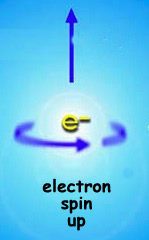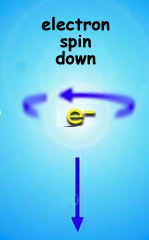Online Introductory Chemistry
Location of electrons in atoms, shells, subshells, electron spin
|
|
|
Quantized energy levels: Total Energy, Kinetic plus Potential |
|
Electrons in atoms are in definite energy levels or states. These energies refer to the total energy for the electron. This means the kinetic plus the potential energy. An unusual feature of electrons and atoms is that the energy is "quantized" or restricted to definite values. We do not see quantum jumps on a daily basis with large objects. Big things appear to gradually change and have continuous energy states, with no restrictions or jumps. The emission spectra of atoms provides the proof of the quantum theory as it applies to atoms and subatomic particles. Every element can be made to emit light that is characteristic for that element. This is consistent with the idea that each element has a unique energy level pattern. The light emitted by an element's atoms matches the possible jumps betweeen energy levels for the electrons in the atoms. click here for element emission spectra evidence The total energy for a specific shell is a definite amount. The total can be made up of a high kinetic energy(KE) and a low potential energy(PE). Sometimes the KE is low and the potential energy is high. The total is what counts.
The basic idea is that the electrons in atoms can only have energy values governed by the principle quantum number "n". The principle quantum number can have only positive whole number values. This means no fractions and no negative numbers. The allowed values for "n" are 1, 2, 3, up to infinity. Electrons in atoms typically only use the first seven energy levels. This matches the seven rows of the periodic table. |
|
Number of electrons in a shell or level |
|
The principle quantum number "n" is very useful. It provides a way to dtermine the maximum number of elecytrons that can fit into a shell. The number of electrons that can fit into a shell is given by the following formula.
This means that the first shell can hold only two electrons. The second shell with n = 2 can hold only eight, 8, electrons.
|
|
Distance between nucleus and an electron |
|
The principle quantum number "n" is very useful. It tells the relative energy for an electron in an atom and it also indicates the average distance between the nucleus and an electron. The higher the value for "n" the greater the distance between the nucleus and the electron. An electron in the first level, n = 1, is closer to the center of the atom's nucleus on average than an electron in the n = 4 shell. |
|
Shells, number of subshells, and order of filling |
|
The shells or energy levels are also divided into sublevels or subshells. The labels for these subshells comes from the observations of light emitted by atoms. The labels for subshells are s for sharp, p for principle, d for diffuse, f for fine. The physical connections end with the f sublevel class. The relative energies for these sublevels are as follows.
The value for "n" equals the number of sublevels for a level. This means the first shell or level has only one sublevel. The second level with "n" equal to two has two sublevels. Check the table below to see what happens for big "n" values. Thankfully, the number of electrons (112) in the biggest atom known can be accommodated by using only the common s, p, d, and f sublevels. The subshells g, h, i etc. are never needed. |
|
|
|
type of subshells |
|
|
|
s |
|
|
|
s and p |
|
|
|
s, p, d |
|
|
|
s, p, d, f |
|
|
|
s, p, d, f, g |
|
|
|
s, p, d, f, g, h |
|
|
|
s, p, d, f, g, h, i |
Electron spin, paramagnetism, magnetism and ferromagnetism |
|
Electrons behave like they are small magnets. They act like they are spinning like a top.
click for more The direction of the magnetic field generated by the "spinning " electron is limited to two extremes. The "UP" and the "DOWN" conditions. The electron spin can be cancelled when two electrons of opposite spin are in the same orbital as happens in helium, He 1s2. The helium atom shows no magnetic properties. Atoms with an odd number of electrons like lithium, Li 1s2 2s1 are paramagnetic. Atoms and ions with unpaired electrons are "paramagnetic". They exert a magnetic field. Atoms with many unpaired electrons exert a stronger magnetic field. These observable properties are one piece of evidence for our model of electron configurations. In metals like iron the unpaired electrons act in concert and form "domains" with an increased magnetic character. This is called ferromagnetism. Free radicals are particles that have an unpaired electron. Their existence is detected by checking for magnetic fields. The radicals are reactive and are believed to play a role in aging and initiation of cancer. Antioxidants are molecules that react with free radicals and remove them. This keeps them from reacting with normal molecules in the body.
|

